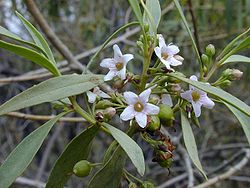| Myoporum | |
|---|---|
 | |
| Naio ( Myoporum sandwicense ) | |
| Scientific classification | |
| Kingdom: | Plantae |
| Clade: | Tracheophytes |
| Clade: | Angiosperms |
| Clade: | Eudicots |
| Clade: | Asterids |
| Order: | Lamiales |
| Family: | Scrophulariaceae |
| Tribe: | Myoporeae |
| Genus: | Myoporum Banks & Sol. ex G.Forst. [1] |
| Species | |
See text. | |
Myoporum is a genus of flowering plants in the figwort family, Scrophulariaceae (formerly placed in Myoporaceae). There are 30 species in the genus, eighteen of which are endemic to Australia although others are endemic to Pacific Islands, including New Zealand, and one is endemic to two Indian Ocean islands. They are shrubs or small trees with leaves that are arranged alternately and have white, occasionally pink flowers and a fruit that is a drupe.